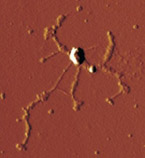|
Hula-Hoop DNA Amplification
Periodic nanostructures made of gold nanoparticles and long DNA strands with repeated sequences have been prepared by Michael Brook, Yingfu Li, and colleagues at McMaster University, in Hamilton, Canada. Their approach exploits a technique for duplicating DNA known as "rolling circle amplification" or the "hula-hoop" technique.
DNA is one of the materials of choice for scientists hoping to create the building blocks of nanotechnology. It is very stable and mechanically strong and, because of its molecular recognition, properties can be formed into predictable structures. Brook and Li have now successfully made periodic three-dimensional nanostructures from long single strands of DNA and gold nanoparticles. They suggest such structures could be the prototype for the components of nanocomputers, nanocircuits, and highly sensitive biosensors.
The Canadian team has used the DNA duplication technique known as "rolling circle amplification". In this approach, a ring of single-stranded DNA is used as the template for duplicate production, while the polymerase enzyme that "reads" the model and builds the corresponding complementary strand has a special characteristic. Once the first duplication is complete, this particular polymerase, unlike ordinary members of the enzyme family, continues working. It separates the fresh double-stranded helix and continues to copy the template again and again with no interruption. This, the researchers explain, leads to long (theoretically infinitely long) single strands of DNA with a sequence of repeating patterns.
 To construct their nanotech building blocks, the team attached short DNA fragments to gold nanoparticles with a diameter of 15 nm. Tiny rings of DNA were then hooked using specific base pairs and a hula-hoop-capable form of polymerase was added. The result was a fringe of long DNA chains dangling from the gold spheres. Next, the team added smaller gold particles (5 nm diameter), each equipped with one short DNA segment. The sequence of these fragments was complementary to one region of the repeated sequence of the long DNA chains, so the fragments docked on to the larger structure. Because the pattern periodically repeats, the long DNA strands were thus equipped with many little gold particles at regular intervals, like beads on a necklace. The result is a periodic nanostructure, say the researchers. To construct their nanotech building blocks, the team attached short DNA fragments to gold nanoparticles with a diameter of 15 nm. Tiny rings of DNA were then hooked using specific base pairs and a hula-hoop-capable form of polymerase was added. The result was a fringe of long DNA chains dangling from the gold spheres. Next, the team added smaller gold particles (5 nm diameter), each equipped with one short DNA segment. The sequence of these fragments was complementary to one region of the repeated sequence of the long DNA chains, so the fragments docked on to the larger structure. Because the pattern periodically repeats, the long DNA strands were thus equipped with many little gold particles at regular intervals, like beads on a necklace. The result is a periodic nanostructure, say the researchers.
"The construction and microstructure of such three-dimensional nano-entities can easily be controlled," explains Brook, "Because DNA base pairing can also be broken up, these structures can be reversibly put together and taken apart again." The team considers this one of the main advantages of their "nanoconstruction kit".
http://www.science.mcmaster.ca/biochem/faculty/li/
Angew Chem Int Edn 2006, 45, 2409, http://dx.doi.org/0.1002/anie.200600061
|

